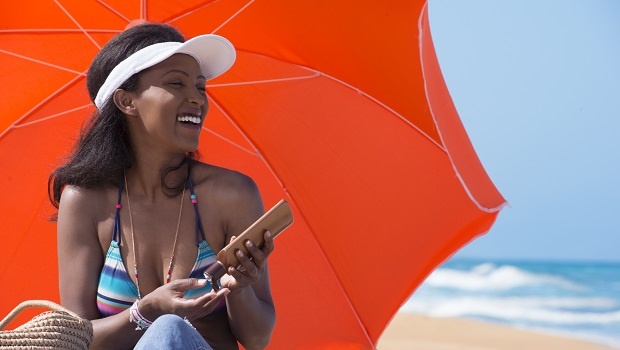
Itching to give your pasty skin a little colour? Here’s what goes on when you step outside without protection… and what to do if you feel the burn.
You slip into your bikini
Your skin is the colour it is because of melanin, pigment molecules produced by melanocyte cells in the basal layer of the epidermis. Melanin protects the cells in the epidermis by converting UV rays into heat. More melanin = darker skin = more natural sun protection.
The problem is that most of us don’t have enough for complete protection. Where there’s no melanin, UV rays almost instantly start to damage the DNA in your epidermis by interfering with its chemical structure.
READ MORE: Ever wonder why you still end up burnt — even after applying SPF?
You’re going red
One response to the damage is erythema, the dilation of blood and inflammatory cells – your skin gets red, puffy and sore – as your body amps up blood flow to try and nourish cells and speed up healing.
Through a process called melanogenesis, your body, now in protection mode, speeds up melanin formation. It will take around three days for these pigments – your tan – to reach the outer layer of your skin.
You blister
When sun damage is really bad and cells in the dermis are affected, your skin blisters. Again, this is damage control – the blister (which contains plasma) protects new skin layers as they form underneath.
READ MORE: 8 sunscreens that won’t leave you a greasy, ashy mess this summer
You start to peel
The damaged surface cells die and flake off. Your body works overtime to replace them – particularly keratinocytes, which make up most of the epidermis – and cells are pushed up faster than normal.
Without the regular processes of maturation and separation, they’re still bundled together when they reach the surface, causing your skin to peel. But it’s the deeper cell damage that can be a problem.
Enzymes begin repairs almost immediately, but sometimes things go wrong – remember, UV rays have altered the cells’ chemistry – and mutations occur. Over time those mutated cells multiply, which can result in skin cancer.
READ MORE: Are you wearing the right sunscreen for your skin type?
Okay, so now that you’ve got the lowdown on your burn, how do you treat it? Ease the sting with these easy steps:
1. Hydrate well. Sunburns are super dehydrating. Heal and hydrate from the inside out by guzzling liquids, ASAP. Drink water with electrolytes (try adding an electrolyte packet or a squeeze of fresh lemon).
Or try some unsweetened iced tea: The antioxidants in green and black tea may help repair free radical damage from the sun. You’ll know you’re fully hydrated when your urine runs pale yellow.
2. Load up on aloe. Aloe vera is a healing wonder, especially for sun-parched skin. It’s laden with anti-inflammatory compounds to calm angry skin, heal burns, and boost immunity (which takes a beating under the sun).
Look for pure aloe vera (that is, 98 to 100% aloe vera) to avoid feeling sticky. And store it in the fridge so it goes on cool—sweet sunburn relief!
3. Bathe with baking soda. Baking soda is fabulous for two reasons: It helps balance your skin’s pH to aid healing, and when dissolved in water, it feels super cool and nourishing against hot and irritated skin.
Add a few heaping tablespoons of baking soda to a cool bath and soak for 15 to 20 minutes. If you don’t want to take the plunge, add a heaping tablespoon of baking soda to a bowl of cool water, soak a washcloth in it, gently wring and use as a compress to treat tender areas.
4. Avoid soap and skip scrubbing. Soap can be drying for skin and when you’re burned, you don’t need anything stripping away moisture. Keep soap use to a minimum (like, say, just suds up your pits and privates) and skip the washcloth or loofah for now.
And forgo shaving (or waxing—ouch!) for a few days to minimise irritation. If you must shave, be sure to lube up thoroughly with a rich, moisturising shaving cream, gel, or lotion.
5. Moisturise to the max. Reach for the richest moisturiser you can get your hands on to soothe skin and prevent peeling. Avoid moisturisers with alcohols, retinols and AHAs (alpha hydroxyl acids), which can dry and irritate sensitive skin. Slather up immediately after bathing for maximum absorption, and chill the bottle in the fridge for cooling comfort.
6. Dust with powder. Fitted clothes can make a sunburn even more painful. Dust your shoulders, ribcage, and bikini lines with body powder or baby powder to prevent chafing and irritation from the elastic in bras and underwear. Look for a powder free from artificial fragrances, which can irritate sensitive skin.
Looking for more sun care tips? Here’s what you need to know about heat rash and heat stroke, plus six things we bet you never knew about your SPF.
This article was originally published on Women's Health




 Publications
Publications
 Partners
Partners















